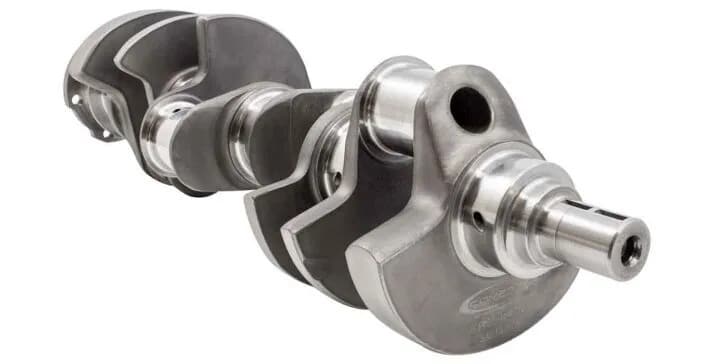Factors of Crankshaft Selection
From the high-performance powerplants propelling Top Fuel dragsters to the subdued engines found in family sedans and grocery getters, each crank must be tailored to, and appropriate for, its specific application.

We know a crankshaft plays a critical role in an engine’s performance, converting reciprocating motion into rotary motion while serving as the backbone of the entire system. It must be strong enough to withstand the continuous pounding of rods and pistons, yet possess enough elasticity to absorb vibrations and flex, albeit slightly, when needed.
As rotating speed increases, so do the forces exerted by the components in the rotating assembly. The resulting impact can reach magnitudes in the thousands of pounds, which means if your crankshaft isn’t up to the task or situation you’re placing it into, then the whole operation has little (or no) chance of long-term survival.

From the high-performance powerplants propelling Top Fuel dragsters to the subdued engines found in family sedans and grocery getters, each crank must be tailored to, and appropriate for, its specific application.
Aligning Options, Expectations & Budgets
With the vast array of crankshafts either readily available or able to be custom-built, product selection is critical. In fact, when it comes to choosing the right crank for a build, the possibilities are almost endless, and can be potentially overwhelming without some direction.
Consider that last year alone, Callies Performance Products in Fostoria, OH, produced upwards of 650 different part numbers for the Chevy small block; it did the same for the Chevy big block. “As the big block world evolved, all of a sudden your standard 4.840” bore spacing wasn’t enough,” says Brook Piper of Callies. “Then, we added a 4.900”. Then, that wasn’t big enough, so we went to 5.000” bore spacing. Well, they’re saying there’s not enough power there, so let’s go to 5.300”. It’s all so fragmented now. In the crankshaft world, that’s what makes everything so difficult – you get into all the diversity as far as rod journals and main journal diameters and things like that. The amount of variation is pretty incredible.”
With that in mind, job one for engine builders, according to Tom Lieb, founder of Scat in Redondo Beach, CA, should be establishing what he calls ‘the fence post around the engine build.’
“What that means is the expectation of the retail customer,” Lieb says. “You’ve got to ask, ‘What are you going to build an engine with? Are you starting from scratch or do you have some parts that you want to use and you need to buy parts to fill in the blank spaces?’ Then, you have to ask, ‘What are your expectations and are they reasonable?’”
To illustrate his point, Lieb cites the hypothetical customer who wants to bolt on a blower and expects the engine to make 800 horsepower, but he wants to buy a cast crank. Well, that’s not compatible; it’s subject to failure.

According to Alan Davis at Eagle Specialty Products in Southaven, MS, selection issues often stem from simple miscalculations typically on the end user’s part.
“One customer with a twin-turbocharged drag engine called us recently to say his crank broke,” Davis recalls. “He had gotten a cast crankshaft – a drag race engine with an entry-level crank. Sure, it may hold up for a couple of weekends, but pretty soon it’s going to fail. They just didn’t grasp what was required to handle what their car could do.”
On the flip side, it’s also not unheard of for customers to overspend on a forged, high-end crank when a simple cast unit will do.
“Say you’ve got a 383 Chevy small block that’s making 400 hp,” Davis says. “Guys are saying, ‘I want a $1,000 forged crank’ when a much more affordable $300 one will do everything they need. Do you really need to spend that much money? If a $300 crankshaft will do, that’s what we’ll recommend.”
Davis’ approach coincides with Lieb’s follow-up question for customers once the intended purpose of the build and performance expectations have been determined. Next, you have to understand the type of budget available.
“It starts with his wallet and what he can afford,” Lieb adds. “He may want a supercharger, but he can only afford a $200 cast crank. If the engine builder’s smart, he won’t build that engine because he knows he’s going to get into trouble with it.”
A Balancing Act
In race applications especially, weight limitations on cranks often mean striking a balance between staying within the rules and maintaining adequate strength. “Say your class has a 49-lb. crank rule,” Davis says, “and a normal, off-the-shelf forged crank is 53-lbs. What you’ll see is racers try to whittle that extra weight off in the wrong places, and now you’ve got balancing issues.”
Saving a few dollars on a crank that’s difficult to balance may wind up costing more in total when the crankshaft is balanced. It’s also important to differentiate between an externally balanced crank and an internally balanced crank.
“Internal balance means all of the weight counteracting the bobweight is contained in the crankshaft counterweights themselves,” Davis says. “In an external balance, weights exist on the damper and flywheel to aid in the balancing of the crankshaft.”

Internal balancing is preferred in racing applications, Davis points out, because it keeps the opposing weights of the rods and pistons closer to the same plane of rotation as the counterweights, which reduces bending stress in the crankshaft itself at high rpm. External balancing is common on certain OEM applications because it can be easier in several respects, and because low-power, stock applications simply are not designed for high-stress environments.
It’s important for customers to understand on the front end what they’re getting into when it comes to balancing, and how costs associated with getting it wrong can quickly add up.
“We had a customer who bought an external balance crank because it was cheaper than internal balance,” Davis notes, “but he wanted to internally balance it and it required heavy metal to be added to it. That’s an additional $300 for the heavy metal when you could have just spent the extra $105 for an internal balance crank.”
At Mile High Crankshafts in Denver, CO, Dave Olsen fields requests all the time from customers asking to lighten their cranks. While it may be simple enough to whittle away at the counterweight, drill holes and cut a 60-lb. crank down to 40-lbs., it’s not necessarily the best thing for an engine.
“Anything we would do to a crankshaft looking for gains and horsepower, and making it faster and better; for the amount of work that goes into it, I don’t really think there is that much gain,” Olsen says. “In fact, it could be detrimental in the sense that the crank now doesn’t have enough body for the strength they want out of it.”
To remedy the situation, Olsen says you then have to balance the crank and likely put $1,000 of Mallory metal back into it to where it’s able to tolerate the opposing forces. “That’s pretty counterproductive right there,” Olsen admits. “You see that all the time.”
Engine building has never been free from the rumor mill, and stories of purpose-built 40-lb. cranks can and do make the rounds at lightning speed, Olsen warns, “but the end result is when they get it balanced and put back together, chances are they’re going to be plagued with bearing issues, because now the crank is like a jump rope in the block – it’s moving all over the place.”
The lesson, he says, is that unless you’re limited by class rules or some other hard restriction, a crank’s weight shouldn’t be as much of a deal breaker as it’s often made out to be. “What the manufacturers and a lot of engine builders have found is they can tolerate a little bit heavier crank and the performance levels are going to be almost exactly the same.”

Elsewhere, Lieb points out that in cases where the engine builder may opt for a shorter stroke – be it a high-revving application or when using power adders – going with a shorter connecting rod can bring its own set of challenges, particularly in supporting the balance.
“If you’re running a stock-length rod on a stroker-type crank,” he says, “the piston, at BDC comes down on the counterweights, so you’ve got to cut material off the counterweight to have the piston clear a full rotation.”
However, removing material from the counterweight only multiplies the problem. Taking material off the crankshaft’s throw side, which is where you need strength, can cause the crank to break in the front because your dampener, the material that you removed, makes the crank weaker.
“Everything they’re doing is backwards,” Lieb says. “You’re making the crank weaker, but you’re increasing the stroke to increase the horsepower, and so on. Again, you’re taking metal away, so the crank breaks. Then, most likely when it breaks in the front it also breaks the block, and that takes out a couple of connecting rods… it’s just catastrophic.”
Avoiding Failures
Speaking of catastrophic, the responsibilities placed on the crankshaft’s shoulders, and the forces and pressures it’s subject to on a continual basis, means failures can and do occur. The causes of those failures can run the gamut, from improper part selection to imprecise balancing and/or weight addition or subtraction. Oftentimes, however, a postmortem reveals the crankshaft wasn’t actually the guilty party.
Take, for example, the aforementioned supercharger, and the increased load it places on the crank, particularly at the nose. Now, consider that the crankshaft nose on a Chevy small block measures 1.650” in diameter. When a supercharger is added and you’re underdriving it, or going 1:1, the torque being placed on the nose of the crank becomes substantially different from when the blower was added; an overdrive situation further compounds the issue.

While the expectation is that speeding up the supercharger produces more pressure and ultimately more horsepower, what isn’t always apparent is the increased stress being placed on the crank.
“People don’t realize the nose of the crank needs to be reinforced,” Lieb says. “You’re pulling this torque off the nose of the crank, and you’ve got to have the strength to keep the nose on. The nose breaks off and what happens? You’ve got another failure.
“For a supercharger, we make cranks with a larger diameter nose,” he adds, noting that in these cases it may be advisable to choose a crank with a big block nose. “Then, you’ve got to get a different hub for your dampener, and a different timing gear setup. But it keeps everything together.”
This is all to reinforce the point that when allowed to do its job, the crank is adept at managing the dynamic forces within the engine. After all, the crankshaft’s design requires an intricate balance between strength and flexibility. Understanding its role and the factors that contribute to its success or failure will go a long way toward ensuring a smooth-running, long-lasting engine setup.


